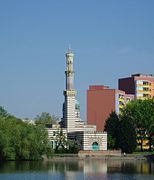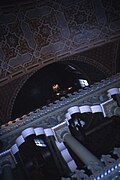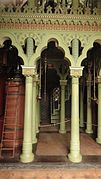Steam engine house for Sanssouci
The former steam engine house for Sanssouci - also known as the "pump house" or "mosque" - is located in Potsdam on the Neustädter Havel bay . It was created at the request of King Friedrich Wilhelm IV. In the years 1841 to 1843 under the direction of Ludwig Persius to operate the large fountain in front of the Sanssouci Palace . It is one of the historical landmarks of civil engineering in Germany and represents an outstanding example of oriental architecture .
history
As early as the 18th century, Frederick the Great needed a lot of water for his planned fountains , the Neptune grotto and a marble colonnade in Sanssouci Park, which no longer exists . Water games were an important element in the landscape architecture of the Baroque . The planning provided for water to be pumped from the Havel by means of wind pumps onto the ruin mountain - which was later named - in the high basin built there. Through a system of tubes made of hollowed out tree trunks, the water flowing down into the park was supposed to cause the water features to gush through its own pressure. Although Friedrich invested a lot of money in the project, it was unsuccessful, mainly due to the builder's lack of technical knowledge. After endless efforts and enormous consumption of materials, the king's wish for water features was finally given up in 1780.
60 years later the technical possibilities had matured. The steam engine house was equipped with a two-cylinder steam engine from Borsigwerke from 1842. To operate the machine, 4 tons of hard coal were required daily, from which an output of 82 HP (60 kW) was generated with an efficiency of 3%; the coal supply came from Silesian mines over the Havel. The energy obtained in this way was used to supply the water reservoir on the ruin mountain with the water of the Havel via a pressure pipe totaling 1.8 kilometers long, as originally planned, from which the fountains in Sanssouci Park and the grounds of the court gardening were supplied . The Great Fountain below the Sanssouci Palace reached a height of 38 m, a technical record of the time. The steam engine was the most powerful of its kind in Germany. The original steam engine was shut down after 50 years of reliable operation before it was replaced by a new, more powerful steam engine with 160 HP (118 kW) in 1895. Since 1937 this has been replaced by two electrically operated centrifugal pumps , which have been controlled by microprocessors since 1992 . Today, in addition to the parks, the Potsdam Botanical Garden, which emerged from a district nursery, continues to receive Havel water from the basin on the ruin mountain.
In September 1985 the steam engine house was opened to the public as a museum and technical monument . The original still preserved steam engine is set in motion by an electric motor during opening hours . In 2007 the pump house was nominated for the award as a historical landmark of civil engineering in Germany .
architecture
At the request of the king, the building was built “in the style of Turkish mosques with a minaret as a chimney”. Although the inclusion of foreign architectural styles was quite common at the time, it is the only building of its kind in Potsdam. Both inside and outside the "Mosque of Potsdam", Ludwig Persius oriented himself on a style of Moorish architecture, which is known as Moorish-influenced late classicism . The building probably owes the elaborate design of a functional house to its exposed location on the banks of the Havel. The steam engine house was then visible from the royal garden terrace in Sanssouci.
photos
- Exterior views
View from the Havel , 2007
- Interior views
Similar plants
Pump houses were also set up for the other parks in the Potsdam park landscape. However, these can be assigned to the style of Norman architecture without exception :
- Steam engine house in Babelsberg Park - built around the same time.
- Court gardener and machine house in the park of Klein-Glienicke - a few years older; the machine house is not independent, but an extension to a water tower.
- Machine or pump house as an extension of the dairy in the New Garden - built around 20 years later.
literature
- Faithful to God: The fountain construction in Sanssouci . In: Zeitschrift für Bauwesen , Volume 2 (1852), Sp. 252–270, 372–392, 458–481, plates 50–51. Volume 3 (1853), col. 197-210, 459-466, plates 29-35, 61-63, 76-77. Digitized in the holdings of the Central and State Library Berlin .
- Helmut Caspar: A mosque as a pump house . In: Berlin monthly magazine ( Luisenstädtischer Bildungsverein ) . Issue 8, 1999, ISSN 0944-5560 , p. 79-82 ( luise-berlin.de ).
Web links
- Entry in the monument database of the State of Brandenburg
- Steam engine house (mosque) . Website of the Prussian Palaces and Gardens Foundation ( SPSG )
- Steam engine house. ( Memento from December 5, 2010 in the Internet Archive ) Official website of the city of Potsdam
- The mosque (steam engine house) in Potsdam. ( Memento from April 5, 2005 in the Internet Archive ) Technology Museum Brandenburg
- Photo gallery of the steam engine house
Individual evidence
- ↑ "Mosque" is a monument to engineering. MAZ-Online, October 19, 2017, accessed on October 19, 2017 .
Coordinates: 52 ° 23 ′ 46.5 ″ N , 13 ° 2 ′ 40.5 ″ E










